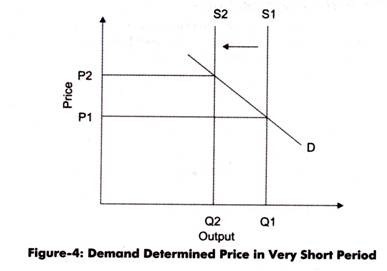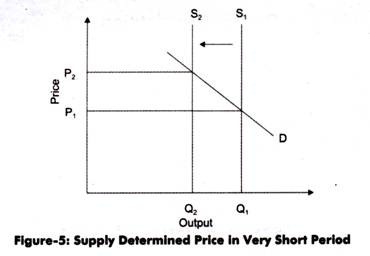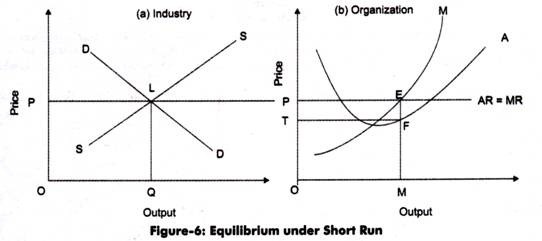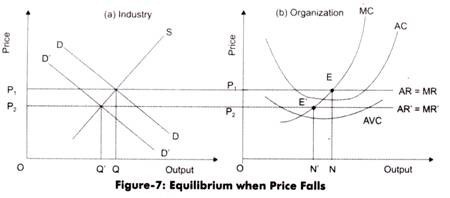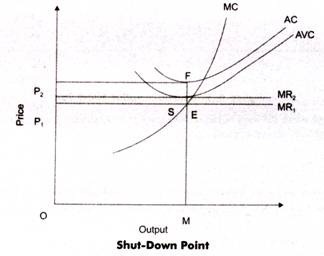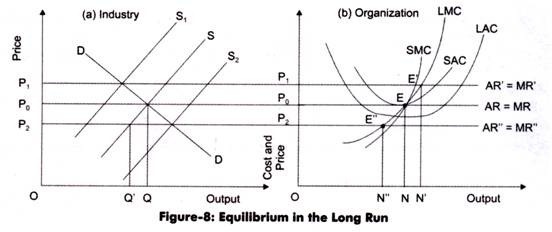Price determination under perfect competition can be analyzed into three periods:
i. Very Short Period:
Refers to a time period in which quantity supplied of a product cannot be increased with increase in its demand.
In simple terms, in very short period of time, the supply of a product is fixed. For example, a confectioner has 20 pastries at a particular time.
ADVERTISEMENTS:
After an hour, a customer requires 40 pieces of pastries. In such a case, the confectioner cannot prepare 20 more pastries in an hour and can only supply 20 pastries. Therefore, the supply is fixed, which is 20 in the given example. The price determined in very short period is known as market price.
ii. Short Period:
Refers to a time period in which the level of supply of a particular product can be increased, but only as per the production capacity of an organization. For example, an organization can produce 50 mobile phones in a day. This is the maximum production capacity of the organization.
Suppose the demand of mobile phones increases to 150 per day for three days. In such a scenario, the organization cannot install new machines or hire more labor in three days to meet the additional demand. Thus, the supply is fixed even in short period and the price determined in this period is known as sub-normal price.
ADVERTISEMENTS:
iii. Long Period:
Refers to a period in which the supply of a product can be increased or decreased with the changing level of demand. In this period, organizations can install new machines or hire more labor to meet the supply requirements.
Generally, in the long period, demand is determined by change in the size of population and change in customer’s tastes and preferences.’ On the other hand, organizations can reduce production level if there is decrease in demand. Therefore, it can be said that in the long period, the price of a product is influenced by supply. The price in the long period is called normal price.
Let us discuss determination of price under these three periods in the next sections.
ADVERTISEMENTS:
Price Determination in Very Short Period:
In very short period, the total supply of a product is fixed. Every organization has a fixed stock of product to be sold thus supply curve IS perfectly inelastic in very short period of time. Thus, the price of a product is influenced by demand.
Figure-4 shows price determination in very short period when demand influences the price:
As shown in Figure-4, supply is fixed, which is SQ. The demand curve for a product is represented by Di. The demand curve Di and supply curve S intersect each other at point A. Therefore, the equilibrium is attained at point A when the price is P, and output as OQ.
Suppose there is an increase in the demand of the product, there would be a shift in the demand curve from D, to D2. In such a case, the price will increase from P, to P2, while supply remains the same at OQ. Now, the demand curve D2 and supply curve S intersect each other at point B. Thus, P2 is the new determined price in very short period.
Now, suppose the demand for a product is fixed and its supply decreases due to various reasons, such as floods and increase in prices of raw materials.
Figure-5 shows price determination in very short period when supply influences the price:
As shown in Figure-5, due to a natural calamity, the supply curve shifts from S1 to S2 and price increases from P1 to P2, while quantity demanded remains the same. Therefore, new equilibrium price is P2. The examples of very short run markets include daily fish market and stock market.
ADVERTISEMENTS:
Price Determination in Short Period:
A short run refers to a period in which organizations do not change their scale of production. In this period, organizations neither exit the industry nor do new organizations enter the industry. In this period, it is possible to increase or decrease the supply of variable inputs. Thus, supply curve is elastic in nature.
Figure-6 shows the price determination under short run:
ADVERTISEMENTS:
Generally, organizations have to select the level of output and price that maximizes their profits.
In perfect competition, profit is maximized at the following conditions:
i. MR=MC= Price
ADVERTISEMENTS:
ii. MC curve must be rising at the point of equilibrium
In Figure-6 (a), the price determination for the industry is shown at the intersection of demand and supply curves at price OP1 and quantity OQ1. This price is fixed for all the organizations in the industry. At price OP1, an organization has to adjust output to maximize profit. In Figure-6 (b), the organization’s MR is shown by MR=AR line. When the prevailing price in the market is P1, the profit is maximized at point E, where MR= MC.
To determine how much profits are being made by the organization, let us introduce AC curve in Figure-6(b). Profit is equal to AR (price) minus AC. In Figure-6 (b), total profits equal EF as AR equals ME and AC equals MF. Thus, area of profit equals P1EFT. These are the super-normal profits earned by the organization.
At this level of profits, there is a tendency for new organizations to enter in the market. However, organizations cannot enter in short run. The organizations in the industry will be at equilibrium at point E, but industry as a whole will not be in equilibrium.
Let us take the case when price falls from P1 to P2.
This is shown in Figure-7:
ADVERTISEMENTS:
In Figure-7(a), the demand curve DD shifts to D’D’. This implies that there is a fall in demand. This reduces the price from P1 to P2. In Figure-7(b), P2 is the prevailing price in the market such that it lies below the AC curve. The equilibrium is achieved at point E’ where MR’= MC. AR’ is less than AC, thus organization will make loss.
The losses may force organizations to quit the industry. However, it is rational for organizations to continue producing in the short run. This is because if organizations keep on earning revenue, they would be able to cover fixed costs and variable costs.
Thus, in the short run, perfectly competitive organizations earn profits. However, in certain situations, they have to incur losses. If the organization fixes the price higher than the market price, it may not be able to sell its products in the competitive market. On the contrary, if it fixes the price below the market price, it has to incur losses.
EXHIBIT-1
Shut-Down Point:
ADVERTISEMENTS:
The question arises why organizations continue producing, if they are incurring losses. As we know that in the short run, fixed factors cannot be altered. Therefore, have to bear the cost of fixed factors even if it shuts down its business. Stopping the production in the short run only helps m avoiding variable costs. Therefore, if an organization is able to earn more than its variable costs, it should keep operating.
If a price is such a low that an organization is unable to cover variable costs, it should plan to shut down.
This can be explained through the following figure:
In the preceding figure, price is P, shown below the AVC and AG curve. It can be seen that at this price, an organization is unable to cover variable costs. Thus, at this point, it should not produce any level of output. The point at which AVC intersects MR2 and MC is the shut-down point, S.
Equilibrium in Long Run:
ADVERTISEMENTS:
The Ion. run refers to a period in which organizations can easily change variable and fixed factors, such as labor machinery and capital, ill the factors are variable in the long run. Organizations can expand the fixed equipment or can replace them. In addition, in this period, organizations can easily enter or exit the industry.
The long run AC and MC curves are relevant for the price and output decisions. ATC is also the important determinant for equilibrium point in the long run. In the long period of time, the following two conditions must be satisfied for attaining equilibrium.
Price = MC
Price = AC
Or, Price = MC = AC
If price is greater than AC, organizations would make supernormal profits, which would influence new organizations to enter the industry. More organizations will increase the supply of the product and thus, the price of the product will fall. This will happen till price reaches AC and all organizations are earning only normal profits.
ADVERTISEMENTS:
On the other hand, if price is below AC, organizations would incur losses. Organizations start exiting that leads to fail in supply. This increases the price to AC. Thus, remaining organizations will start making the normal profits.
It should be noted that when AC falls, MC is less than AC and when AC rises, MC is more than AC. Thus, MC=AC at the point where AC is neither falling nor rising that is the minimum point of AC curve.
Thus, the equilibrium condition can be rewritten as:
Price = MC = Minimum of AC
The long-run equilibrium is shown with the help of Figure-8:
In long run, organizations can enter and exit the industry. In Figure-8, when price is OP1, equilibrium is achieved at point E’. At this point, AR is greater than AC, thus profits are gained. This lures other organizations to enter the industry. This will shift the supply curve of the industry from S1 to S2. Thus, price will fall from OP1 to OP2.
At this price, organizations start making loss as AR is less than AC. Thus, most of the organizations will exit the industry. This leads to fall in the product’s supply, further raising the price till P0. Thus, full equilibrium is achieved at the price OP0 and output ON where all the organizations under the industry are earning normal profits.
Here, LMC=Price= minimum LAC. The conclusion that follows from the long-run equilibrium is that the competition forces organizations to produce at the minimum point of AC curve. This is beneficial for consumers as the product is produced at the cheapest possible cost.
